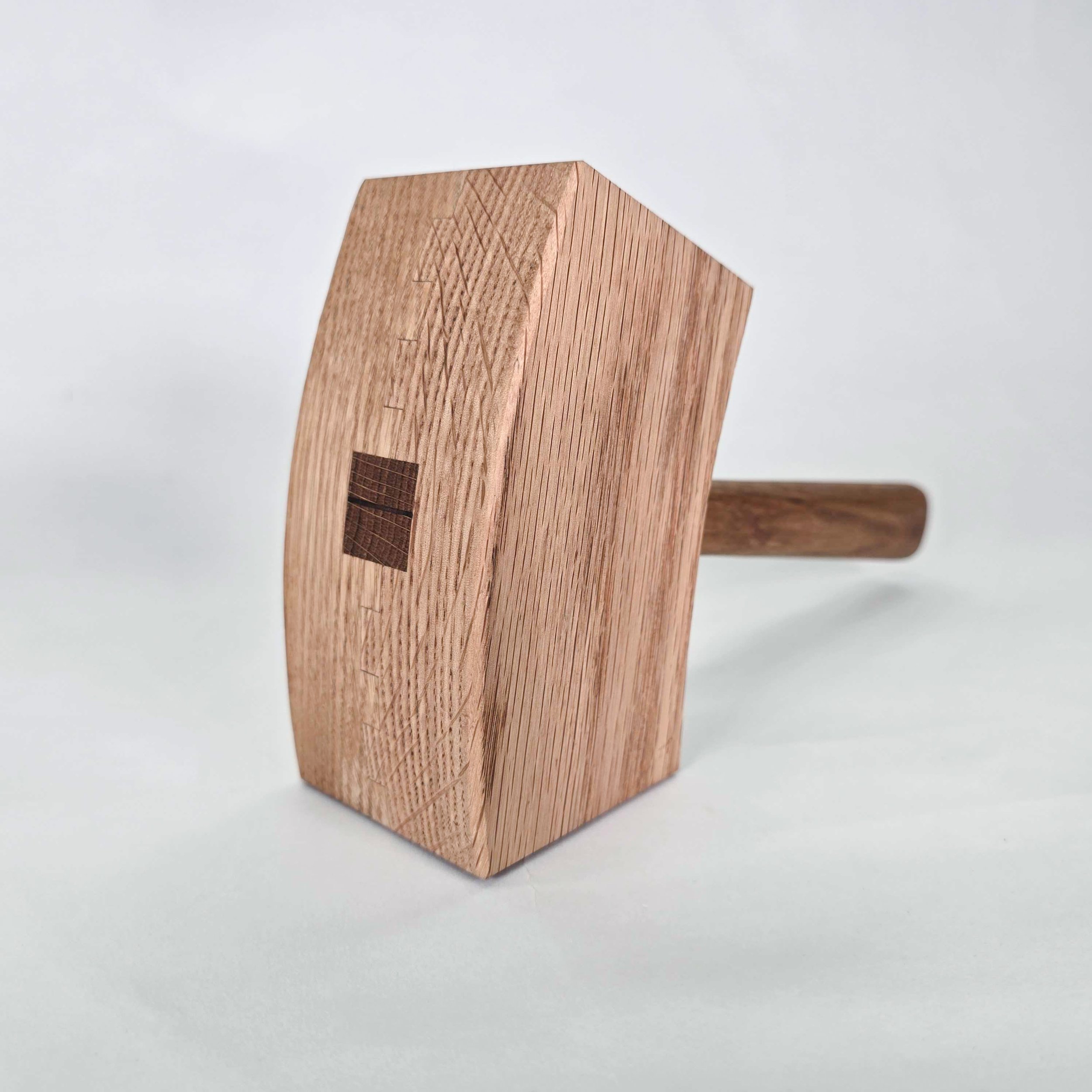 Image 1 of 7
Image 1 of 7

 Image 2 of 7
Image 2 of 7

 Image 3 of 7
Image 3 of 7

 Image 4 of 7
Image 4 of 7

 Image 5 of 7
Image 5 of 7

 Image 6 of 7
Image 6 of 7

 Image 7 of 7
Image 7 of 7








Advanced Joiner's Mallet Kit
For striking wood-handled chisels, a wooden mallet is best. When wood hits wood, the surfaces contract and expand, transferring force with a springy action that’s easy on the arm and wrist. You can buy a wooden mallet, but these are mostly cheap and clumsy, so woodworkers make their own.
Pre-industrial mallets were made by mortising a big chunk of hardwood, but this has gotten tough. Lumberyards don’t carry thick enough stock and chopping that deep mortise is a challenge. Many woodworkers resort to a laminated design, where the head is made from four pieces of stock glued up around the handle. These laminated mallets look amateurish, and they often fall apart. Even modern glues can’t always stand up to the constant pounding of bench work, and laminated mallets can fail in the middle of a project.
Compass Rose has solved this problem with our new Advanced Joiner’s Mallet Kit. Based on a century-old mallet, our kit delivers outstanding ergonomics and solid timber. We’ve redesigned the mallet head with a two-piece, finger-jointed construction. Unlike other laminated mallets, ours has a single joint that fits tightly, even before gluing. Our joint has over 40% more glue surface than a standard lamination and is much more resistant to striking force.
The two-piece design eliminates the need for chopping a deep mortise. Instead, the tapered opening for the handle is built right in. When the mallet is assembled, you lock the head in place by driving a wood wedge into the handle. We’ve included a nice chunk of hardwood for making the wedge.
We made this mallet a kit because you should make your mallet. We’ve handled some of the challenges, but you still need to shape, assemble, personalize, and finish your mallet. It’s a real project that takes a few hours to complete. After your mallet is done, you’ll have a solid wood mallet ready for years of use in the shop.
To help with your mallet build, we’ve made a complete video and a FREE PDF guide that covers all the steps.
The kit includes a two-piece head made from red oak, a handle blank made from white oak, and a piece of dark hardwood (mostly walnut) for making the contrasting wedge. All you need is glue, finish, and basic hand tools to do the shaping.
Please note: Wood mallets are made for tapping wooden chisel handles, wood-bodied planes, and joint assembly. Do not strike non-wood materials with your mallet. Use a hammer for heavy striking tasks. The face of your mallet will show denting and wear over time. Because your mallet is made from solid timbers, you should expect variations in grain, natural mineral stains, and very small knots. These are all normal.
For striking wood-handled chisels, a wooden mallet is best. When wood hits wood, the surfaces contract and expand, transferring force with a springy action that’s easy on the arm and wrist. You can buy a wooden mallet, but these are mostly cheap and clumsy, so woodworkers make their own.
Pre-industrial mallets were made by mortising a big chunk of hardwood, but this has gotten tough. Lumberyards don’t carry thick enough stock and chopping that deep mortise is a challenge. Many woodworkers resort to a laminated design, where the head is made from four pieces of stock glued up around the handle. These laminated mallets look amateurish, and they often fall apart. Even modern glues can’t always stand up to the constant pounding of bench work, and laminated mallets can fail in the middle of a project.
Compass Rose has solved this problem with our new Advanced Joiner’s Mallet Kit. Based on a century-old mallet, our kit delivers outstanding ergonomics and solid timber. We’ve redesigned the mallet head with a two-piece, finger-jointed construction. Unlike other laminated mallets, ours has a single joint that fits tightly, even before gluing. Our joint has over 40% more glue surface than a standard lamination and is much more resistant to striking force.
The two-piece design eliminates the need for chopping a deep mortise. Instead, the tapered opening for the handle is built right in. When the mallet is assembled, you lock the head in place by driving a wood wedge into the handle. We’ve included a nice chunk of hardwood for making the wedge.
We made this mallet a kit because you should make your mallet. We’ve handled some of the challenges, but you still need to shape, assemble, personalize, and finish your mallet. It’s a real project that takes a few hours to complete. After your mallet is done, you’ll have a solid wood mallet ready for years of use in the shop.
To help with your mallet build, we’ve made a complete video and a FREE PDF guide that covers all the steps.
The kit includes a two-piece head made from red oak, a handle blank made from white oak, and a piece of dark hardwood (mostly walnut) for making the contrasting wedge. All you need is glue, finish, and basic hand tools to do the shaping.
Please note: Wood mallets are made for tapping wooden chisel handles, wood-bodied planes, and joint assembly. Do not strike non-wood materials with your mallet. Use a hammer for heavy striking tasks. The face of your mallet will show denting and wear over time. Because your mallet is made from solid timbers, you should expect variations in grain, natural mineral stains, and very small knots. These are all normal.

